Analysis of Pharmaceutical Regulation and the PBS in Australia
VerifiedAdded on 2021/05/31
|12
|3373
|18
Report
AI Summary
This report provides a comprehensive overview of pharmaceutical regulation in Australia, focusing on the Therapeutic Goods Act 1989 and the Pharmaceutical Benefits Scheme (PBS). It examines the drug approval process, the roles of the Therapeutic Goods Administration (TGA) and various committees, and the classification of drugs. The report analyzes the PBS, including its role in subsidizing drug costs, and discusses the increasing pharmaceutical consumption in Australia. It identifies avenues through which drugs may circumvent the PBS and explores policy solutions related to drug patenting, the Therapeutic Group Premium (TGP) policy, and price disclosure. Furthermore, it touches upon the impact of international agreements like TRIPS and TPP on Australia's pharmaceutical regulations, offering insights into the complexities and challenges within the Australian pharmaceutical sector.
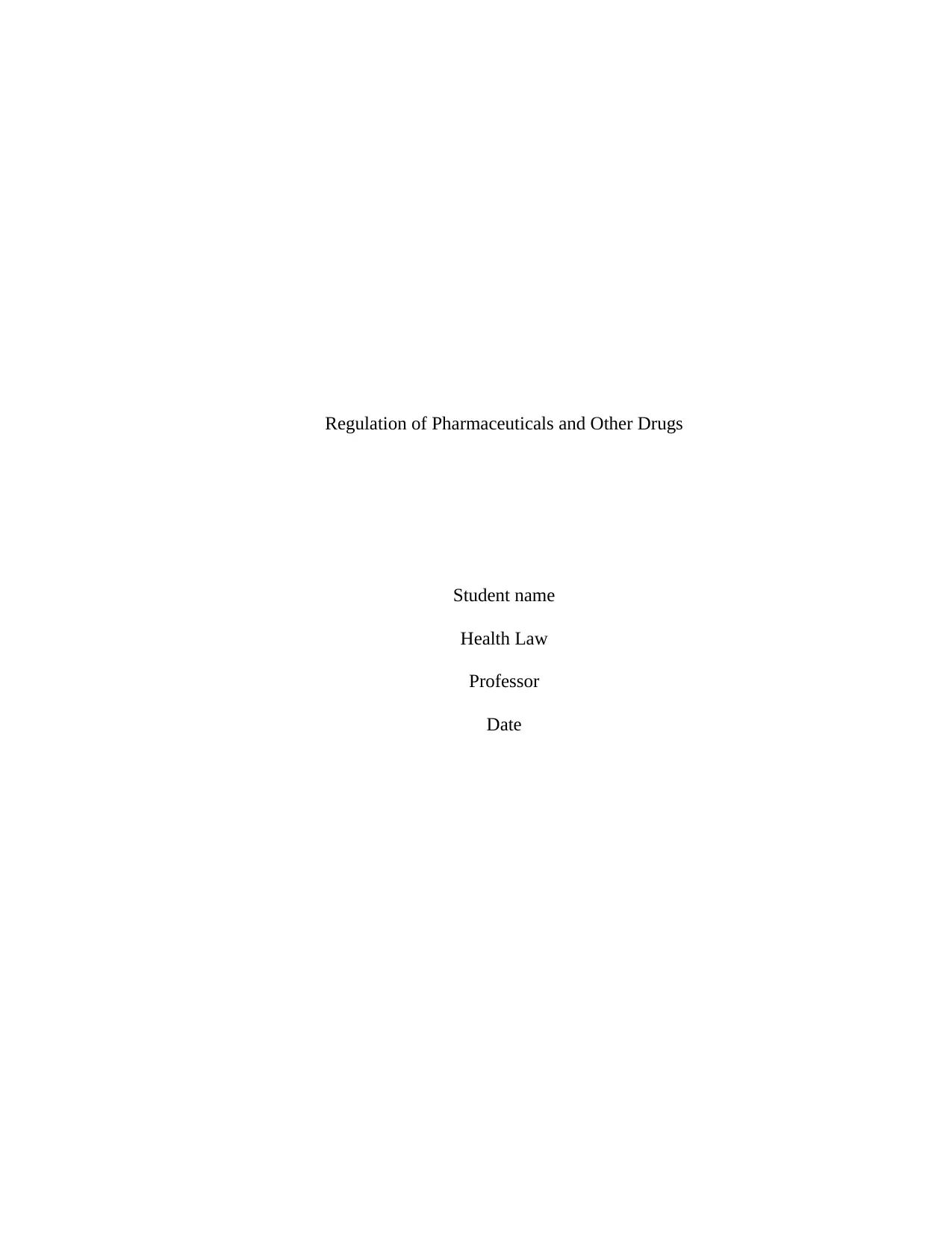
Regulation of Pharmaceuticals and Other Drugs
Student name
Health Law
Professor
Date
Student name
Health Law
Professor
Date
Paraphrase This Document
Need a fresh take? Get an instant paraphrase of this document with our AI Paraphraser
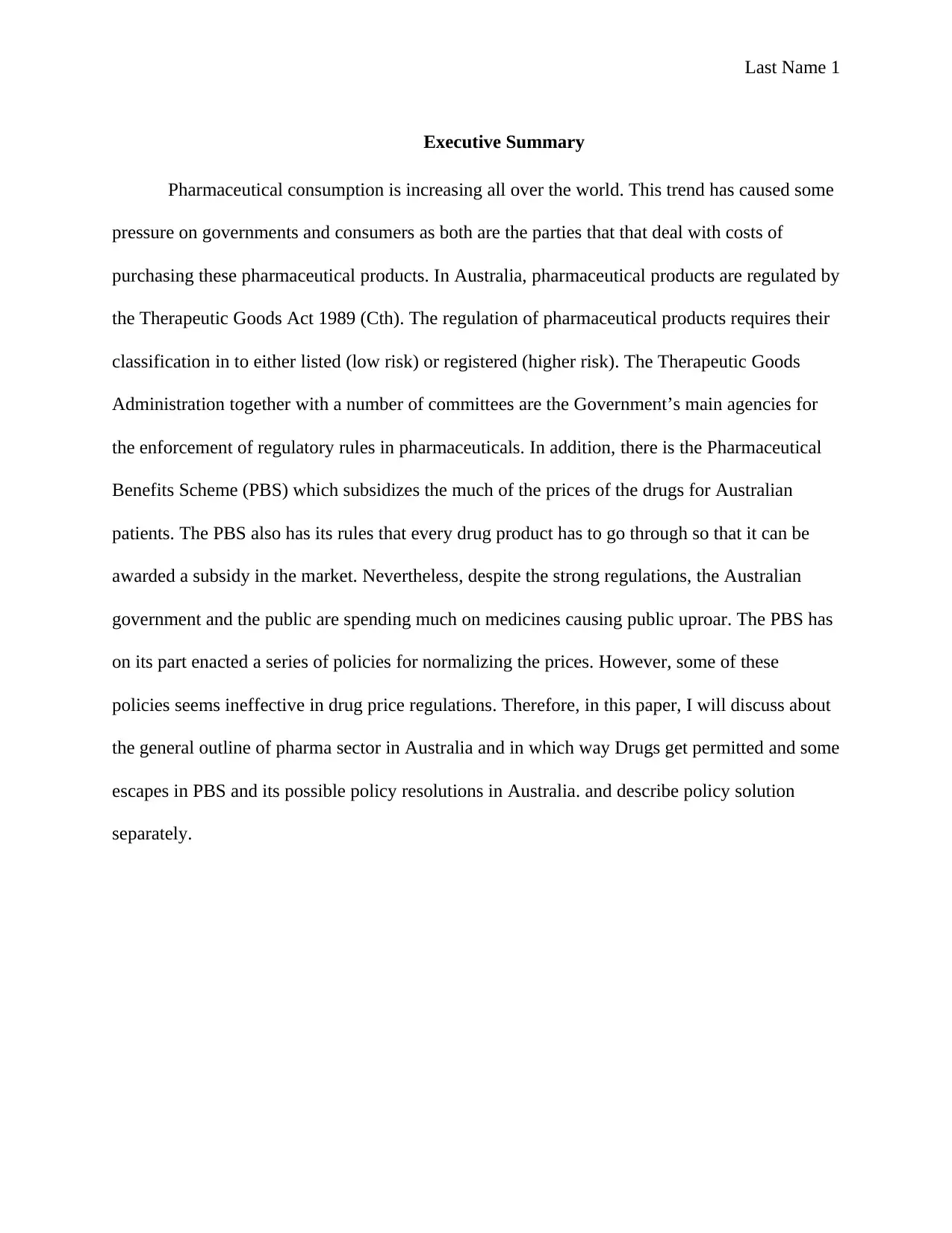
Last Name 1
Executive Summary
Pharmaceutical consumption is increasing all over the world. This trend has caused some
pressure on governments and consumers as both are the parties that that deal with costs of
purchasing these pharmaceutical products. In Australia, pharmaceutical products are regulated by
the Therapeutic Goods Act 1989 (Cth). The regulation of pharmaceutical products requires their
classification in to either listed (low risk) or registered (higher risk). The Therapeutic Goods
Administration together with a number of committees are the Government’s main agencies for
the enforcement of regulatory rules in pharmaceuticals. In addition, there is the Pharmaceutical
Benefits Scheme (PBS) which subsidizes the much of the prices of the drugs for Australian
patients. The PBS also has its rules that every drug product has to go through so that it can be
awarded a subsidy in the market. Nevertheless, despite the strong regulations, the Australian
government and the public are spending much on medicines causing public uproar. The PBS has
on its part enacted a series of policies for normalizing the prices. However, some of these
policies seems ineffective in drug price regulations. Therefore, in this paper, I will discuss about
the general outline of pharma sector in Australia and in which way Drugs get permitted and some
escapes in PBS and its possible policy resolutions in Australia. and describe policy solution
separately.
Executive Summary
Pharmaceutical consumption is increasing all over the world. This trend has caused some
pressure on governments and consumers as both are the parties that that deal with costs of
purchasing these pharmaceutical products. In Australia, pharmaceutical products are regulated by
the Therapeutic Goods Act 1989 (Cth). The regulation of pharmaceutical products requires their
classification in to either listed (low risk) or registered (higher risk). The Therapeutic Goods
Administration together with a number of committees are the Government’s main agencies for
the enforcement of regulatory rules in pharmaceuticals. In addition, there is the Pharmaceutical
Benefits Scheme (PBS) which subsidizes the much of the prices of the drugs for Australian
patients. The PBS also has its rules that every drug product has to go through so that it can be
awarded a subsidy in the market. Nevertheless, despite the strong regulations, the Australian
government and the public are spending much on medicines causing public uproar. The PBS has
on its part enacted a series of policies for normalizing the prices. However, some of these
policies seems ineffective in drug price regulations. Therefore, in this paper, I will discuss about
the general outline of pharma sector in Australia and in which way Drugs get permitted and some
escapes in PBS and its possible policy resolutions in Australia. and describe policy solution
separately.
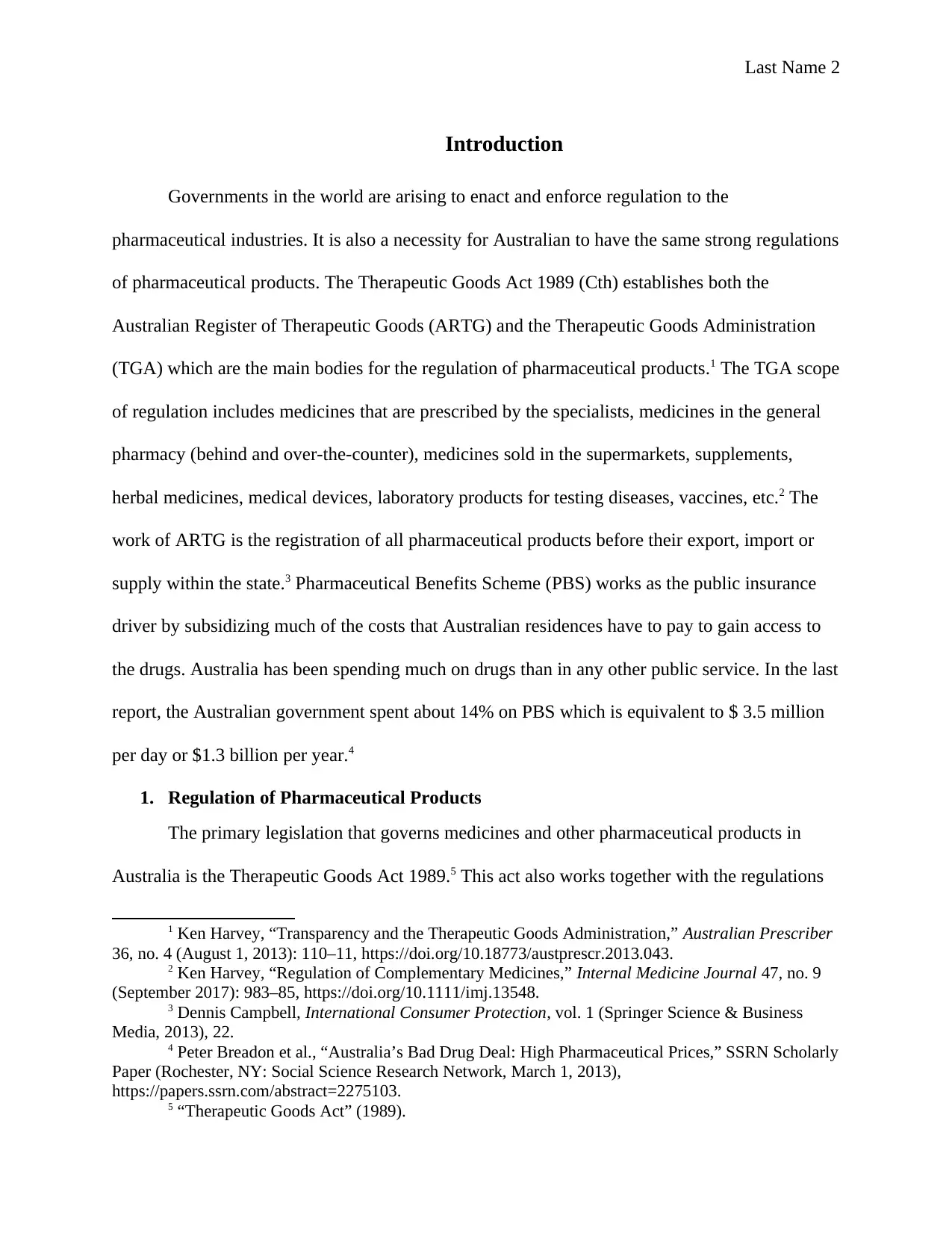
Last Name 2
Introduction
Governments in the world are arising to enact and enforce regulation to the
pharmaceutical industries. It is also a necessity for Australian to have the same strong regulations
of pharmaceutical products. The Therapeutic Goods Act 1989 (Cth) establishes both the
Australian Register of Therapeutic Goods (ARTG) and the Therapeutic Goods Administration
(TGA) which are the main bodies for the regulation of pharmaceutical products.1 The TGA scope
of regulation includes medicines that are prescribed by the specialists, medicines in the general
pharmacy (behind and over-the-counter), medicines sold in the supermarkets, supplements,
herbal medicines, medical devices, laboratory products for testing diseases, vaccines, etc.2 The
work of ARTG is the registration of all pharmaceutical products before their export, import or
supply within the state.3 Pharmaceutical Benefits Scheme (PBS) works as the public insurance
driver by subsidizing much of the costs that Australian residences have to pay to gain access to
the drugs. Australia has been spending much on drugs than in any other public service. In the last
report, the Australian government spent about 14% on PBS which is equivalent to $ 3.5 million
per day or $1.3 billion per year.4
1. Regulation of Pharmaceutical Products
The primary legislation that governs medicines and other pharmaceutical products in
Australia is the Therapeutic Goods Act 1989.5 This act also works together with the regulations
1 Ken Harvey, “Transparency and the Therapeutic Goods Administration,” Australian Prescriber
36, no. 4 (August 1, 2013): 110–11, https://doi.org/10.18773/austprescr.2013.043.
2 Ken Harvey, “Regulation of Complementary Medicines,” Internal Medicine Journal 47, no. 9
(September 2017): 983–85, https://doi.org/10.1111/imj.13548.
3 Dennis Campbell, International Consumer Protection, vol. 1 (Springer Science & Business
Media, 2013), 22.
4 Peter Breadon et al., “Australia’s Bad Drug Deal: High Pharmaceutical Prices,” SSRN Scholarly
Paper (Rochester, NY: Social Science Research Network, March 1, 2013),
https://papers.ssrn.com/abstract=2275103.
5 “Therapeutic Goods Act” (1989).
Introduction
Governments in the world are arising to enact and enforce regulation to the
pharmaceutical industries. It is also a necessity for Australian to have the same strong regulations
of pharmaceutical products. The Therapeutic Goods Act 1989 (Cth) establishes both the
Australian Register of Therapeutic Goods (ARTG) and the Therapeutic Goods Administration
(TGA) which are the main bodies for the regulation of pharmaceutical products.1 The TGA scope
of regulation includes medicines that are prescribed by the specialists, medicines in the general
pharmacy (behind and over-the-counter), medicines sold in the supermarkets, supplements,
herbal medicines, medical devices, laboratory products for testing diseases, vaccines, etc.2 The
work of ARTG is the registration of all pharmaceutical products before their export, import or
supply within the state.3 Pharmaceutical Benefits Scheme (PBS) works as the public insurance
driver by subsidizing much of the costs that Australian residences have to pay to gain access to
the drugs. Australia has been spending much on drugs than in any other public service. In the last
report, the Australian government spent about 14% on PBS which is equivalent to $ 3.5 million
per day or $1.3 billion per year.4
1. Regulation of Pharmaceutical Products
The primary legislation that governs medicines and other pharmaceutical products in
Australia is the Therapeutic Goods Act 1989.5 This act also works together with the regulations
1 Ken Harvey, “Transparency and the Therapeutic Goods Administration,” Australian Prescriber
36, no. 4 (August 1, 2013): 110–11, https://doi.org/10.18773/austprescr.2013.043.
2 Ken Harvey, “Regulation of Complementary Medicines,” Internal Medicine Journal 47, no. 9
(September 2017): 983–85, https://doi.org/10.1111/imj.13548.
3 Dennis Campbell, International Consumer Protection, vol. 1 (Springer Science & Business
Media, 2013), 22.
4 Peter Breadon et al., “Australia’s Bad Drug Deal: High Pharmaceutical Prices,” SSRN Scholarly
Paper (Rochester, NY: Social Science Research Network, March 1, 2013),
https://papers.ssrn.com/abstract=2275103.
5 “Therapeutic Goods Act” (1989).
⊘ This is a preview!⊘
Do you want full access?
Subscribe today to unlock all pages.

Trusted by 1+ million students worldwide
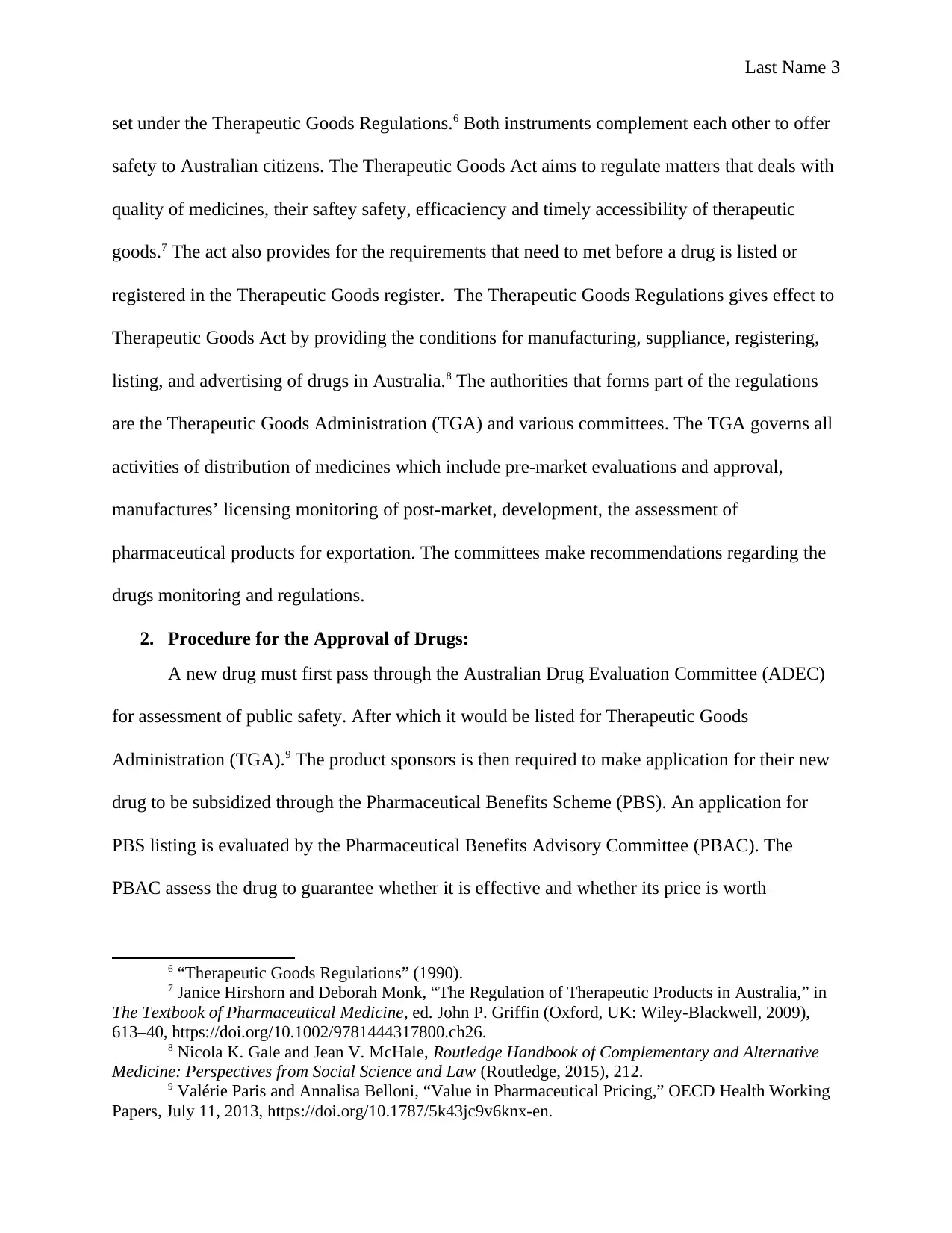
Last Name 3
set under the Therapeutic Goods Regulations.6 Both instruments complement each other to offer
safety to Australian citizens. The Therapeutic Goods Act aims to regulate matters that deals with
quality of medicines, their saftey safety, efficaciency and timely accessibility of therapeutic
goods.7 The act also provides for the requirements that need to met before a drug is listed or
registered in the Therapeutic Goods register. The Therapeutic Goods Regulations gives effect to
Therapeutic Goods Act by providing the conditions for manufacturing, suppliance, registering,
listing, and advertising of drugs in Australia.8 The authorities that forms part of the regulations
are the Therapeutic Goods Administration (TGA) and various committees. The TGA governs all
activities of distribution of medicines which include pre-market evaluations and approval,
manufactures’ licensing monitoring of post-market, development, the assessment of
pharmaceutical products for exportation. The committees make recommendations regarding the
drugs monitoring and regulations.
2. Procedure for the Approval of Drugs:
A new drug must first pass through the Australian Drug Evaluation Committee (ADEC)
for assessment of public safety. After which it would be listed for Therapeutic Goods
Administration (TGA).9 The product sponsors is then required to make application for their new
drug to be subsidized through the Pharmaceutical Benefits Scheme (PBS). An application for
PBS listing is evaluated by the Pharmaceutical Benefits Advisory Committee (PBAC). The
PBAC assess the drug to guarantee whether it is effective and whether its price is worth
6 “Therapeutic Goods Regulations” (1990).
7 Janice Hirshorn and Deborah Monk, “The Regulation of Therapeutic Products in Australia,” in
The Textbook of Pharmaceutical Medicine, ed. John P. Griffin (Oxford, UK: Wiley-Blackwell, 2009),
613–40, https://doi.org/10.1002/9781444317800.ch26.
8 Nicola K. Gale and Jean V. McHale, Routledge Handbook of Complementary and Alternative
Medicine: Perspectives from Social Science and Law (Routledge, 2015), 212.
9 Valérie Paris and Annalisa Belloni, “Value in Pharmaceutical Pricing,” OECD Health Working
Papers, July 11, 2013, https://doi.org/10.1787/5k43jc9v6knx-en.
set under the Therapeutic Goods Regulations.6 Both instruments complement each other to offer
safety to Australian citizens. The Therapeutic Goods Act aims to regulate matters that deals with
quality of medicines, their saftey safety, efficaciency and timely accessibility of therapeutic
goods.7 The act also provides for the requirements that need to met before a drug is listed or
registered in the Therapeutic Goods register. The Therapeutic Goods Regulations gives effect to
Therapeutic Goods Act by providing the conditions for manufacturing, suppliance, registering,
listing, and advertising of drugs in Australia.8 The authorities that forms part of the regulations
are the Therapeutic Goods Administration (TGA) and various committees. The TGA governs all
activities of distribution of medicines which include pre-market evaluations and approval,
manufactures’ licensing monitoring of post-market, development, the assessment of
pharmaceutical products for exportation. The committees make recommendations regarding the
drugs monitoring and regulations.
2. Procedure for the Approval of Drugs:
A new drug must first pass through the Australian Drug Evaluation Committee (ADEC)
for assessment of public safety. After which it would be listed for Therapeutic Goods
Administration (TGA).9 The product sponsors is then required to make application for their new
drug to be subsidized through the Pharmaceutical Benefits Scheme (PBS). An application for
PBS listing is evaluated by the Pharmaceutical Benefits Advisory Committee (PBAC). The
PBAC assess the drug to guarantee whether it is effective and whether its price is worth
6 “Therapeutic Goods Regulations” (1990).
7 Janice Hirshorn and Deborah Monk, “The Regulation of Therapeutic Products in Australia,” in
The Textbook of Pharmaceutical Medicine, ed. John P. Griffin (Oxford, UK: Wiley-Blackwell, 2009),
613–40, https://doi.org/10.1002/9781444317800.ch26.
8 Nicola K. Gale and Jean V. McHale, Routledge Handbook of Complementary and Alternative
Medicine: Perspectives from Social Science and Law (Routledge, 2015), 212.
9 Valérie Paris and Annalisa Belloni, “Value in Pharmaceutical Pricing,” OECD Health Working
Papers, July 11, 2013, https://doi.org/10.1787/5k43jc9v6knx-en.
Paraphrase This Document
Need a fresh take? Get an instant paraphrase of this document with our AI Paraphraser
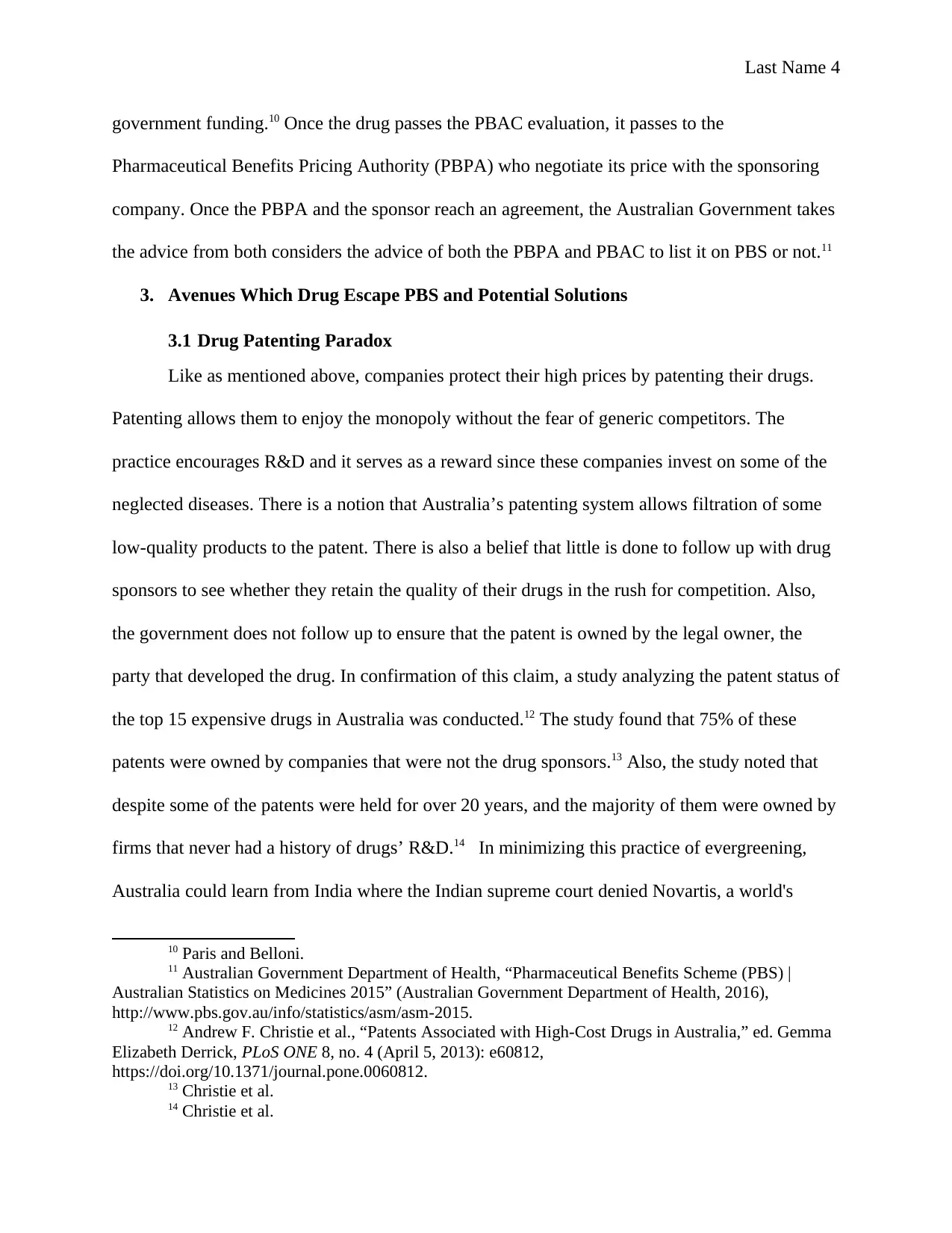
Last Name 4
government funding.10 Once the drug passes the PBAC evaluation, it passes to the
Pharmaceutical Benefits Pricing Authority (PBPA) who negotiate its price with the sponsoring
company. Once the PBPA and the sponsor reach an agreement, the Australian Government takes
the advice from both considers the advice of both the PBPA and PBAC to list it on PBS or not.11
3. Avenues Which Drug Escape PBS and Potential Solutions
3.1 Drug Patenting Paradox
Like as mentioned above, companies protect their high prices by patenting their drugs.
Patenting allows them to enjoy the monopoly without the fear of generic competitors. The
practice encourages R&D and it serves as a reward since these companies invest on some of the
neglected diseases. There is a notion that Australia’s patenting system allows filtration of some
low-quality products to the patent. There is also a belief that little is done to follow up with drug
sponsors to see whether they retain the quality of their drugs in the rush for competition. Also,
the government does not follow up to ensure that the patent is owned by the legal owner, the
party that developed the drug. In confirmation of this claim, a study analyzing the patent status of
the top 15 expensive drugs in Australia was conducted.12 The study found that 75% of these
patents were owned by companies that were not the drug sponsors.13 Also, the study noted that
despite some of the patents were held for over 20 years, and the majority of them were owned by
firms that never had a history of drugs’ R&D.14 In minimizing this practice of evergreening,
Australia could learn from India where the Indian supreme court denied Novartis, a world's
10 Paris and Belloni.
11 Australian Government Department of Health, “Pharmaceutical Benefits Scheme (PBS) |
Australian Statistics on Medicines 2015” (Australian Government Department of Health, 2016),
http://www.pbs.gov.au/info/statistics/asm/asm-2015.
12 Andrew F. Christie et al., “Patents Associated with High-Cost Drugs in Australia,” ed. Gemma
Elizabeth Derrick, PLoS ONE 8, no. 4 (April 5, 2013): e60812,
https://doi.org/10.1371/journal.pone.0060812.
13 Christie et al.
14 Christie et al.
government funding.10 Once the drug passes the PBAC evaluation, it passes to the
Pharmaceutical Benefits Pricing Authority (PBPA) who negotiate its price with the sponsoring
company. Once the PBPA and the sponsor reach an agreement, the Australian Government takes
the advice from both considers the advice of both the PBPA and PBAC to list it on PBS or not.11
3. Avenues Which Drug Escape PBS and Potential Solutions
3.1 Drug Patenting Paradox
Like as mentioned above, companies protect their high prices by patenting their drugs.
Patenting allows them to enjoy the monopoly without the fear of generic competitors. The
practice encourages R&D and it serves as a reward since these companies invest on some of the
neglected diseases. There is a notion that Australia’s patenting system allows filtration of some
low-quality products to the patent. There is also a belief that little is done to follow up with drug
sponsors to see whether they retain the quality of their drugs in the rush for competition. Also,
the government does not follow up to ensure that the patent is owned by the legal owner, the
party that developed the drug. In confirmation of this claim, a study analyzing the patent status of
the top 15 expensive drugs in Australia was conducted.12 The study found that 75% of these
patents were owned by companies that were not the drug sponsors.13 Also, the study noted that
despite some of the patents were held for over 20 years, and the majority of them were owned by
firms that never had a history of drugs’ R&D.14 In minimizing this practice of evergreening,
Australia could learn from India where the Indian supreme court denied Novartis, a world's
10 Paris and Belloni.
11 Australian Government Department of Health, “Pharmaceutical Benefits Scheme (PBS) |
Australian Statistics on Medicines 2015” (Australian Government Department of Health, 2016),
http://www.pbs.gov.au/info/statistics/asm/asm-2015.
12 Andrew F. Christie et al., “Patents Associated with High-Cost Drugs in Australia,” ed. Gemma
Elizabeth Derrick, PLoS ONE 8, no. 4 (April 5, 2013): e60812,
https://doi.org/10.1371/journal.pone.0060812.
13 Christie et al.
14 Christie et al.
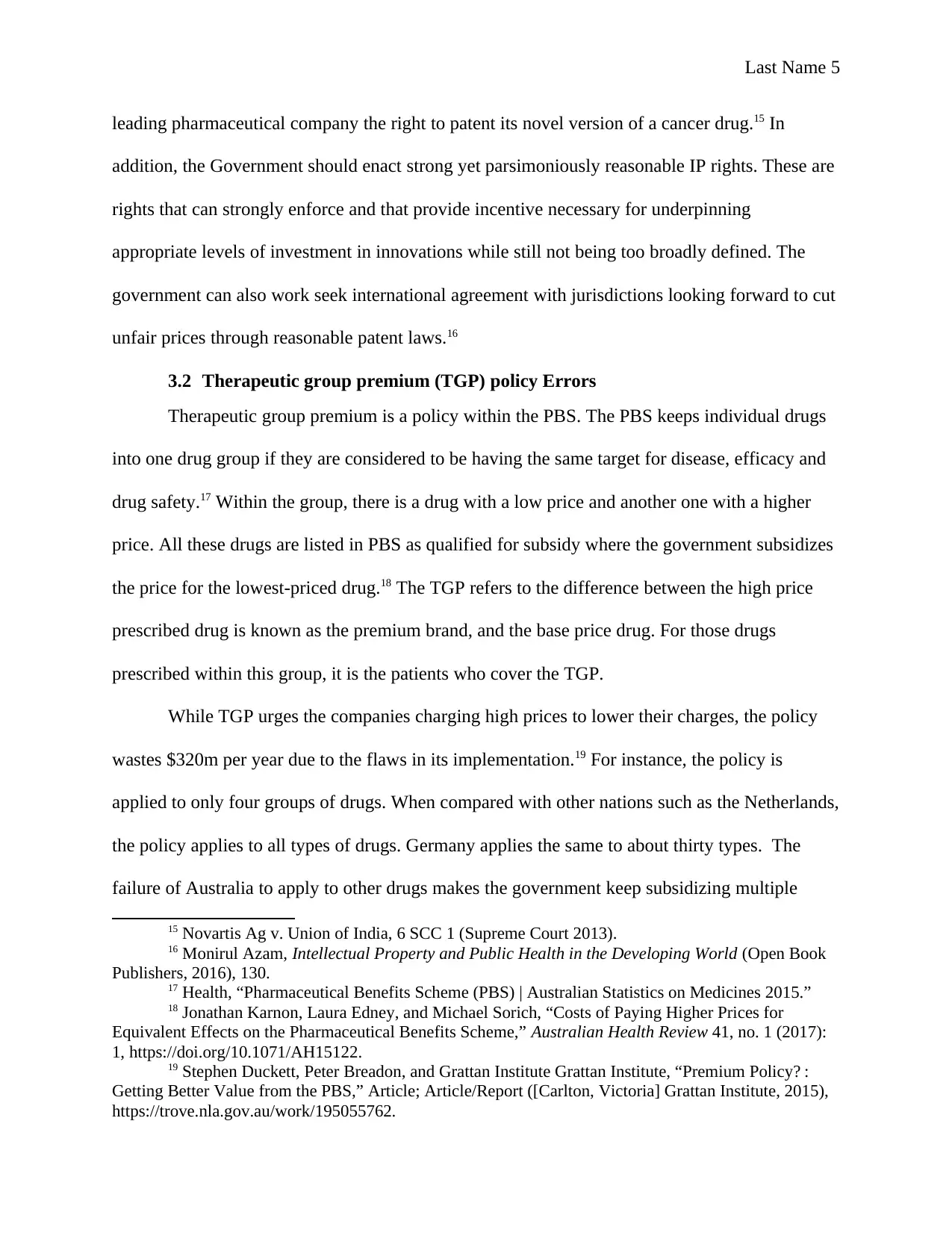
Last Name 5
leading pharmaceutical company the right to patent its novel version of a cancer drug.15 In
addition, the Government should enact strong yet parsimoniously reasonable IP rights. These are
rights that can strongly enforce and that provide incentive necessary for underpinning
appropriate levels of investment in innovations while still not being too broadly defined. The
government can also work seek international agreement with jurisdictions looking forward to cut
unfair prices through reasonable patent laws.16
3.2 Therapeutic group premium (TGP) policy Errors
Therapeutic group premium is a policy within the PBS. The PBS keeps individual drugs
into one drug group if they are considered to be having the same target for disease, efficacy and
drug safety.17 Within the group, there is a drug with a low price and another one with a higher
price. All these drugs are listed in PBS as qualified for subsidy where the government subsidizes
the price for the lowest-priced drug.18 The TGP refers to the difference between the high price
prescribed drug is known as the premium brand, and the base price drug. For those drugs
prescribed within this group, it is the patients who cover the TGP.
While TGP urges the companies charging high prices to lower their charges, the policy
wastes $320m per year due to the flaws in its implementation.19 For instance, the policy is
applied to only four groups of drugs. When compared with other nations such as the Netherlands,
the policy applies to all types of drugs. Germany applies the same to about thirty types. The
failure of Australia to apply to other drugs makes the government keep subsidizing multiple
15 Novartis Ag v. Union of India, 6 SCC 1 (Supreme Court 2013).
16 Monirul Azam, Intellectual Property and Public Health in the Developing World (Open Book
Publishers, 2016), 130.
17 Health, “Pharmaceutical Benefits Scheme (PBS) | Australian Statistics on Medicines 2015.”
18 Jonathan Karnon, Laura Edney, and Michael Sorich, “Costs of Paying Higher Prices for
Equivalent Effects on the Pharmaceutical Benefits Scheme,” Australian Health Review 41, no. 1 (2017):
1, https://doi.org/10.1071/AH15122.
19 Stephen Duckett, Peter Breadon, and Grattan Institute Grattan Institute, “Premium Policy? :
Getting Better Value from the PBS,” Article; Article/Report ([Carlton, Victoria] Grattan Institute, 2015),
https://trove.nla.gov.au/work/195055762.
leading pharmaceutical company the right to patent its novel version of a cancer drug.15 In
addition, the Government should enact strong yet parsimoniously reasonable IP rights. These are
rights that can strongly enforce and that provide incentive necessary for underpinning
appropriate levels of investment in innovations while still not being too broadly defined. The
government can also work seek international agreement with jurisdictions looking forward to cut
unfair prices through reasonable patent laws.16
3.2 Therapeutic group premium (TGP) policy Errors
Therapeutic group premium is a policy within the PBS. The PBS keeps individual drugs
into one drug group if they are considered to be having the same target for disease, efficacy and
drug safety.17 Within the group, there is a drug with a low price and another one with a higher
price. All these drugs are listed in PBS as qualified for subsidy where the government subsidizes
the price for the lowest-priced drug.18 The TGP refers to the difference between the high price
prescribed drug is known as the premium brand, and the base price drug. For those drugs
prescribed within this group, it is the patients who cover the TGP.
While TGP urges the companies charging high prices to lower their charges, the policy
wastes $320m per year due to the flaws in its implementation.19 For instance, the policy is
applied to only four groups of drugs. When compared with other nations such as the Netherlands,
the policy applies to all types of drugs. Germany applies the same to about thirty types. The
failure of Australia to apply to other drugs makes the government keep subsidizing multiple
15 Novartis Ag v. Union of India, 6 SCC 1 (Supreme Court 2013).
16 Monirul Azam, Intellectual Property and Public Health in the Developing World (Open Book
Publishers, 2016), 130.
17 Health, “Pharmaceutical Benefits Scheme (PBS) | Australian Statistics on Medicines 2015.”
18 Jonathan Karnon, Laura Edney, and Michael Sorich, “Costs of Paying Higher Prices for
Equivalent Effects on the Pharmaceutical Benefits Scheme,” Australian Health Review 41, no. 1 (2017):
1, https://doi.org/10.1071/AH15122.
19 Stephen Duckett, Peter Breadon, and Grattan Institute Grattan Institute, “Premium Policy? :
Getting Better Value from the PBS,” Article; Article/Report ([Carlton, Victoria] Grattan Institute, 2015),
https://trove.nla.gov.au/work/195055762.
⊘ This is a preview!⊘
Do you want full access?
Subscribe today to unlock all pages.

Trusted by 1+ million students worldwide
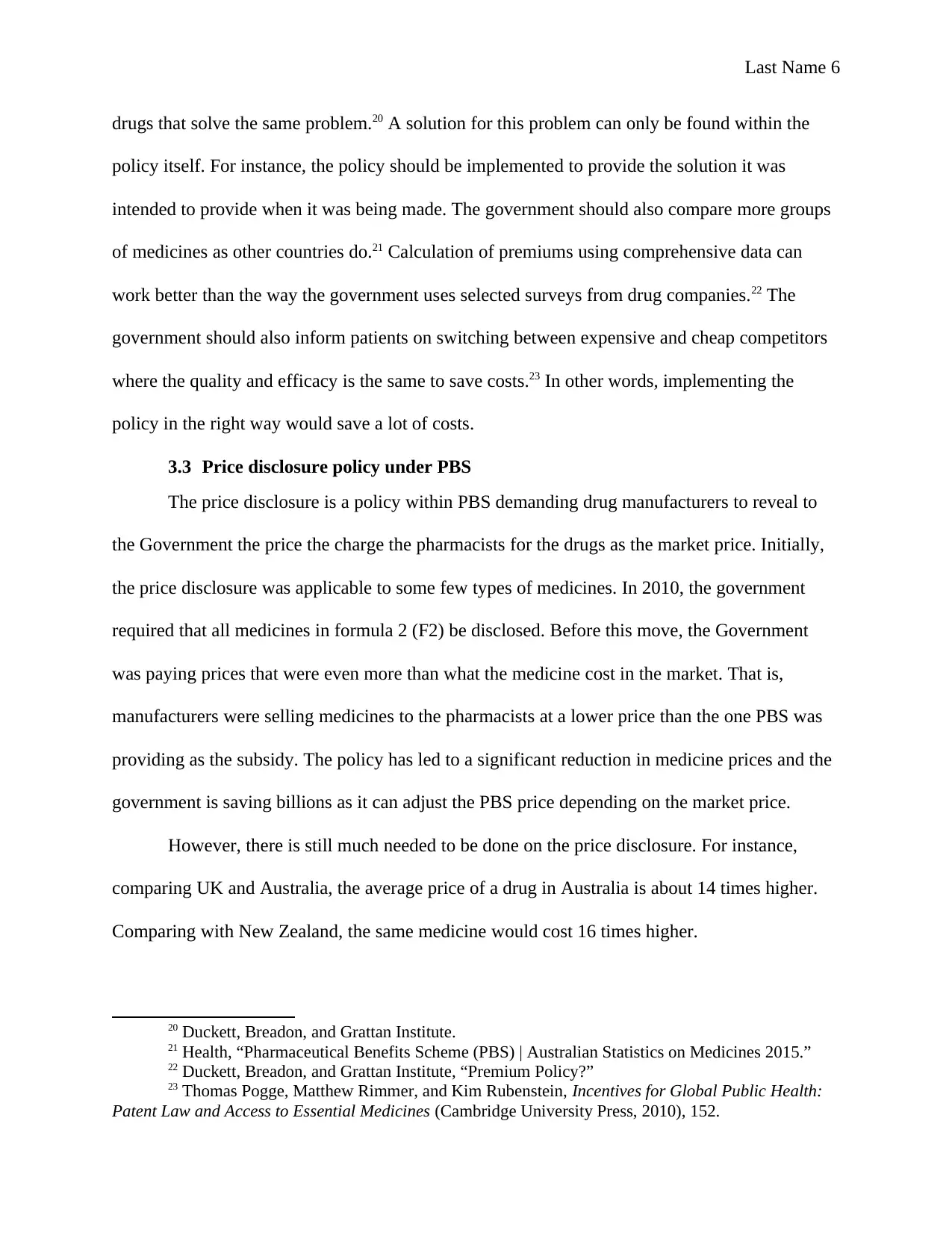
Last Name 6
drugs that solve the same problem.20 A solution for this problem can only be found within the
policy itself. For instance, the policy should be implemented to provide the solution it was
intended to provide when it was being made. The government should also compare more groups
of medicines as other countries do.21 Calculation of premiums using comprehensive data can
work better than the way the government uses selected surveys from drug companies.22 The
government should also inform patients on switching between expensive and cheap competitors
where the quality and efficacy is the same to save costs.23 In other words, implementing the
policy in the right way would save a lot of costs.
3.3 Price disclosure policy under PBS
The price disclosure is a policy within PBS demanding drug manufacturers to reveal to
the Government the price the charge the pharmacists for the drugs as the market price. Initially,
the price disclosure was applicable to some few types of medicines. In 2010, the government
required that all medicines in formula 2 (F2) be disclosed. Before this move, the Government
was paying prices that were even more than what the medicine cost in the market. That is,
manufacturers were selling medicines to the pharmacists at a lower price than the one PBS was
providing as the subsidy. The policy has led to a significant reduction in medicine prices and the
government is saving billions as it can adjust the PBS price depending on the market price.
However, there is still much needed to be done on the price disclosure. For instance,
comparing UK and Australia, the average price of a drug in Australia is about 14 times higher.
Comparing with New Zealand, the same medicine would cost 16 times higher.
20 Duckett, Breadon, and Grattan Institute.
21 Health, “Pharmaceutical Benefits Scheme (PBS) | Australian Statistics on Medicines 2015.”
22 Duckett, Breadon, and Grattan Institute, “Premium Policy?”
23 Thomas Pogge, Matthew Rimmer, and Kim Rubenstein, Incentives for Global Public Health:
Patent Law and Access to Essential Medicines (Cambridge University Press, 2010), 152.
drugs that solve the same problem.20 A solution for this problem can only be found within the
policy itself. For instance, the policy should be implemented to provide the solution it was
intended to provide when it was being made. The government should also compare more groups
of medicines as other countries do.21 Calculation of premiums using comprehensive data can
work better than the way the government uses selected surveys from drug companies.22 The
government should also inform patients on switching between expensive and cheap competitors
where the quality and efficacy is the same to save costs.23 In other words, implementing the
policy in the right way would save a lot of costs.
3.3 Price disclosure policy under PBS
The price disclosure is a policy within PBS demanding drug manufacturers to reveal to
the Government the price the charge the pharmacists for the drugs as the market price. Initially,
the price disclosure was applicable to some few types of medicines. In 2010, the government
required that all medicines in formula 2 (F2) be disclosed. Before this move, the Government
was paying prices that were even more than what the medicine cost in the market. That is,
manufacturers were selling medicines to the pharmacists at a lower price than the one PBS was
providing as the subsidy. The policy has led to a significant reduction in medicine prices and the
government is saving billions as it can adjust the PBS price depending on the market price.
However, there is still much needed to be done on the price disclosure. For instance,
comparing UK and Australia, the average price of a drug in Australia is about 14 times higher.
Comparing with New Zealand, the same medicine would cost 16 times higher.
20 Duckett, Breadon, and Grattan Institute.
21 Health, “Pharmaceutical Benefits Scheme (PBS) | Australian Statistics on Medicines 2015.”
22 Duckett, Breadon, and Grattan Institute, “Premium Policy?”
23 Thomas Pogge, Matthew Rimmer, and Kim Rubenstein, Incentives for Global Public Health:
Patent Law and Access to Essential Medicines (Cambridge University Press, 2010), 152.
Paraphrase This Document
Need a fresh take? Get an instant paraphrase of this document with our AI Paraphraser
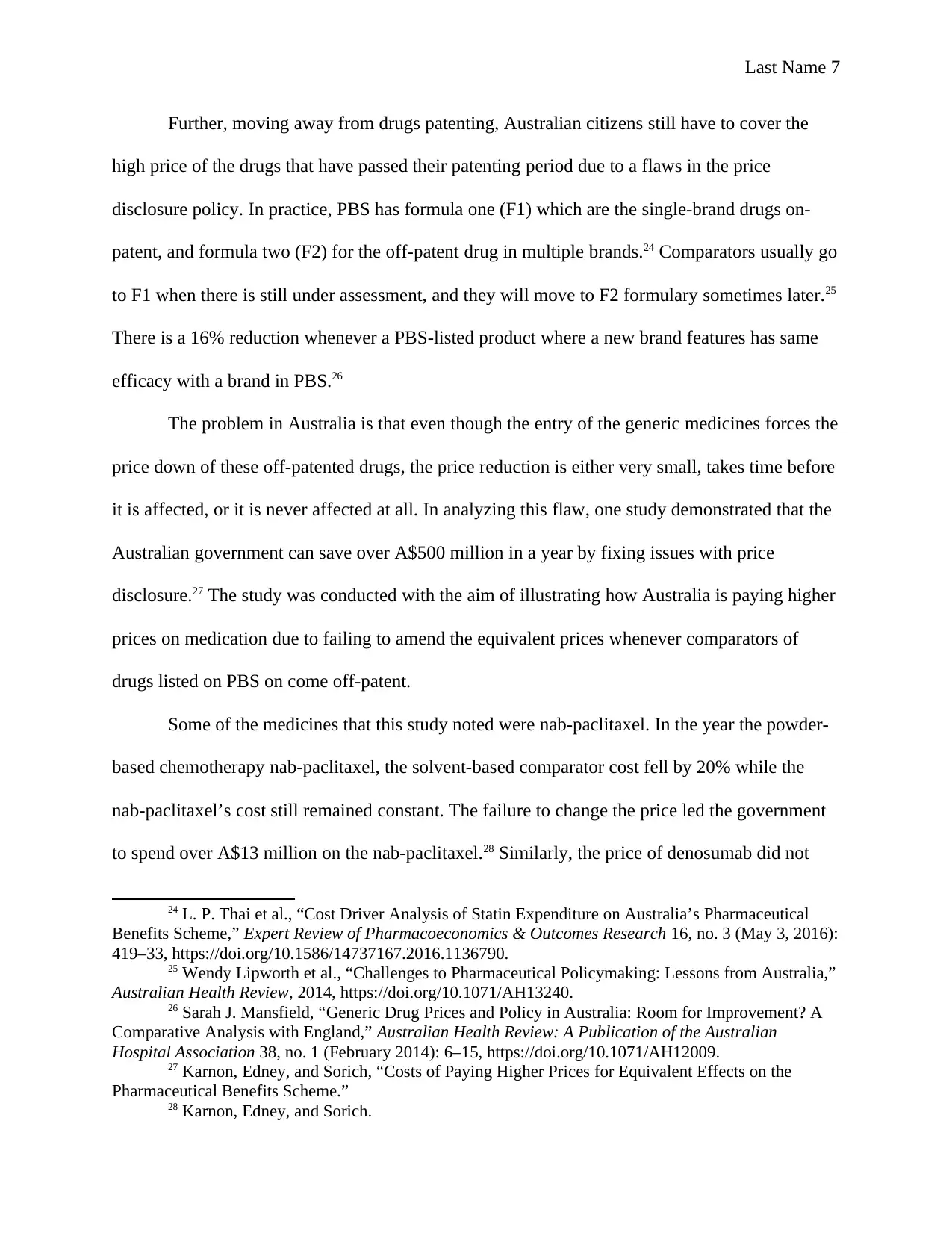
Last Name 7
Further, moving away from drugs patenting, Australian citizens still have to cover the
high price of the drugs that have passed their patenting period due to a flaws in the price
disclosure policy. In practice, PBS has formula one (F1) which are the single-brand drugs on-
patent, and formula two (F2) for the off-patent drug in multiple brands.24 Comparators usually go
to F1 when there is still under assessment, and they will move to F2 formulary sometimes later.25
There is a 16% reduction whenever a PBS-listed product where a new brand features has same
efficacy with a brand in PBS.26
The problem in Australia is that even though the entry of the generic medicines forces the
price down of these off-patented drugs, the price reduction is either very small, takes time before
it is affected, or it is never affected at all. In analyzing this flaw, one study demonstrated that the
Australian government can save over A$500 million in a year by fixing issues with price
disclosure.27 The study was conducted with the aim of illustrating how Australia is paying higher
prices on medication due to failing to amend the equivalent prices whenever comparators of
drugs listed on PBS on come off-patent.
Some of the medicines that this study noted were nab-paclitaxel. In the year the powder-
based chemotherapy nab-paclitaxel, the solvent-based comparator cost fell by 20% while the
nab-paclitaxel’s cost still remained constant. The failure to change the price led the government
to spend over A$13 million on the nab-paclitaxel.28 Similarly, the price of denosumab did not
24 L. P. Thai et al., “Cost Driver Analysis of Statin Expenditure on Australia’s Pharmaceutical
Benefits Scheme,” Expert Review of Pharmacoeconomics & Outcomes Research 16, no. 3 (May 3, 2016):
419–33, https://doi.org/10.1586/14737167.2016.1136790.
25 Wendy Lipworth et al., “Challenges to Pharmaceutical Policymaking: Lessons from Australia,”
Australian Health Review, 2014, https://doi.org/10.1071/AH13240.
26 Sarah J. Mansfield, “Generic Drug Prices and Policy in Australia: Room for Improvement? A
Comparative Analysis with England,” Australian Health Review: A Publication of the Australian
Hospital Association 38, no. 1 (February 2014): 6–15, https://doi.org/10.1071/AH12009.
27 Karnon, Edney, and Sorich, “Costs of Paying Higher Prices for Equivalent Effects on the
Pharmaceutical Benefits Scheme.”
28 Karnon, Edney, and Sorich.
Further, moving away from drugs patenting, Australian citizens still have to cover the
high price of the drugs that have passed their patenting period due to a flaws in the price
disclosure policy. In practice, PBS has formula one (F1) which are the single-brand drugs on-
patent, and formula two (F2) for the off-patent drug in multiple brands.24 Comparators usually go
to F1 when there is still under assessment, and they will move to F2 formulary sometimes later.25
There is a 16% reduction whenever a PBS-listed product where a new brand features has same
efficacy with a brand in PBS.26
The problem in Australia is that even though the entry of the generic medicines forces the
price down of these off-patented drugs, the price reduction is either very small, takes time before
it is affected, or it is never affected at all. In analyzing this flaw, one study demonstrated that the
Australian government can save over A$500 million in a year by fixing issues with price
disclosure.27 The study was conducted with the aim of illustrating how Australia is paying higher
prices on medication due to failing to amend the equivalent prices whenever comparators of
drugs listed on PBS on come off-patent.
Some of the medicines that this study noted were nab-paclitaxel. In the year the powder-
based chemotherapy nab-paclitaxel, the solvent-based comparator cost fell by 20% while the
nab-paclitaxel’s cost still remained constant. The failure to change the price led the government
to spend over A$13 million on the nab-paclitaxel.28 Similarly, the price of denosumab did not
24 L. P. Thai et al., “Cost Driver Analysis of Statin Expenditure on Australia’s Pharmaceutical
Benefits Scheme,” Expert Review of Pharmacoeconomics & Outcomes Research 16, no. 3 (May 3, 2016):
419–33, https://doi.org/10.1586/14737167.2016.1136790.
25 Wendy Lipworth et al., “Challenges to Pharmaceutical Policymaking: Lessons from Australia,”
Australian Health Review, 2014, https://doi.org/10.1071/AH13240.
26 Sarah J. Mansfield, “Generic Drug Prices and Policy in Australia: Room for Improvement? A
Comparative Analysis with England,” Australian Health Review: A Publication of the Australian
Hospital Association 38, no. 1 (February 2014): 6–15, https://doi.org/10.1071/AH12009.
27 Karnon, Edney, and Sorich, “Costs of Paying Higher Prices for Equivalent Effects on the
Pharmaceutical Benefits Scheme.”
28 Karnon, Edney, and Sorich.
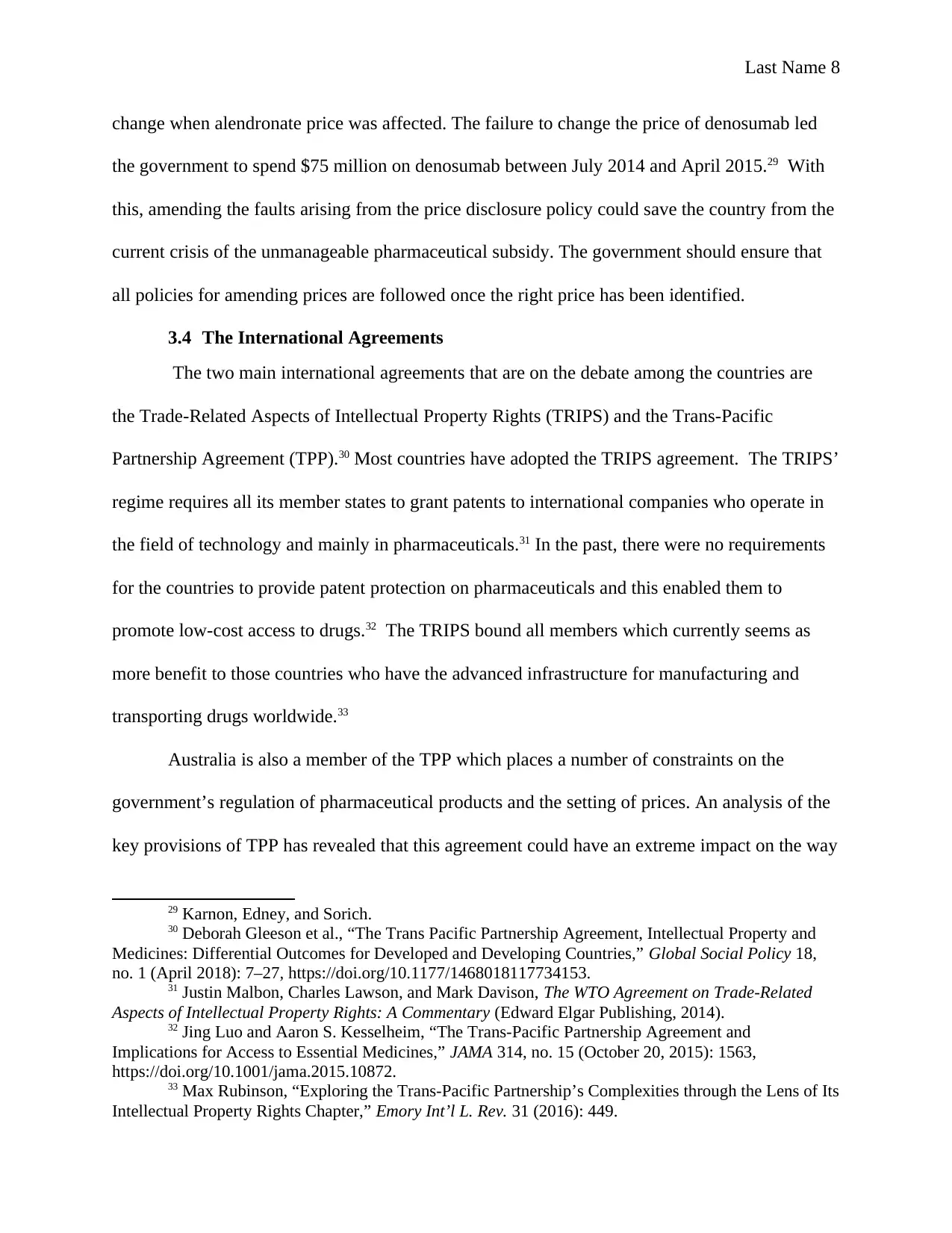
Last Name 8
change when alendronate price was affected. The failure to change the price of denosumab led
the government to spend $75 million on denosumab between July 2014 and April 2015.29 With
this, amending the faults arising from the price disclosure policy could save the country from the
current crisis of the unmanageable pharmaceutical subsidy. The government should ensure that
all policies for amending prices are followed once the right price has been identified.
3.4 The International Agreements
The two main international agreements that are on the debate among the countries are
the Trade-Related Aspects of Intellectual Property Rights (TRIPS) and the Trans-Pacific
Partnership Agreement (TPP).30 Most countries have adopted the TRIPS agreement. The TRIPS’
regime requires all its member states to grant patents to international companies who operate in
the field of technology and mainly in pharmaceuticals.31 In the past, there were no requirements
for the countries to provide patent protection on pharmaceuticals and this enabled them to
promote low-cost access to drugs.32 The TRIPS bound all members which currently seems as
more benefit to those countries who have the advanced infrastructure for manufacturing and
transporting drugs worldwide.33
Australia is also a member of the TPP which places a number of constraints on the
government’s regulation of pharmaceutical products and the setting of prices. An analysis of the
key provisions of TPP has revealed that this agreement could have an extreme impact on the way
29 Karnon, Edney, and Sorich.
30 Deborah Gleeson et al., “The Trans Pacific Partnership Agreement, Intellectual Property and
Medicines: Differential Outcomes for Developed and Developing Countries,” Global Social Policy 18,
no. 1 (April 2018): 7–27, https://doi.org/10.1177/1468018117734153.
31 Justin Malbon, Charles Lawson, and Mark Davison, The WTO Agreement on Trade-Related
Aspects of Intellectual Property Rights: A Commentary (Edward Elgar Publishing, 2014).
32 Jing Luo and Aaron S. Kesselheim, “The Trans-Pacific Partnership Agreement and
Implications for Access to Essential Medicines,” JAMA 314, no. 15 (October 20, 2015): 1563,
https://doi.org/10.1001/jama.2015.10872.
33 Max Rubinson, “Exploring the Trans-Pacific Partnership’s Complexities through the Lens of Its
Intellectual Property Rights Chapter,” Emory Int’l L. Rev. 31 (2016): 449.
change when alendronate price was affected. The failure to change the price of denosumab led
the government to spend $75 million on denosumab between July 2014 and April 2015.29 With
this, amending the faults arising from the price disclosure policy could save the country from the
current crisis of the unmanageable pharmaceutical subsidy. The government should ensure that
all policies for amending prices are followed once the right price has been identified.
3.4 The International Agreements
The two main international agreements that are on the debate among the countries are
the Trade-Related Aspects of Intellectual Property Rights (TRIPS) and the Trans-Pacific
Partnership Agreement (TPP).30 Most countries have adopted the TRIPS agreement. The TRIPS’
regime requires all its member states to grant patents to international companies who operate in
the field of technology and mainly in pharmaceuticals.31 In the past, there were no requirements
for the countries to provide patent protection on pharmaceuticals and this enabled them to
promote low-cost access to drugs.32 The TRIPS bound all members which currently seems as
more benefit to those countries who have the advanced infrastructure for manufacturing and
transporting drugs worldwide.33
Australia is also a member of the TPP which places a number of constraints on the
government’s regulation of pharmaceutical products and the setting of prices. An analysis of the
key provisions of TPP has revealed that this agreement could have an extreme impact on the way
29 Karnon, Edney, and Sorich.
30 Deborah Gleeson et al., “The Trans Pacific Partnership Agreement, Intellectual Property and
Medicines: Differential Outcomes for Developed and Developing Countries,” Global Social Policy 18,
no. 1 (April 2018): 7–27, https://doi.org/10.1177/1468018117734153.
31 Justin Malbon, Charles Lawson, and Mark Davison, The WTO Agreement on Trade-Related
Aspects of Intellectual Property Rights: A Commentary (Edward Elgar Publishing, 2014).
32 Jing Luo and Aaron S. Kesselheim, “The Trans-Pacific Partnership Agreement and
Implications for Access to Essential Medicines,” JAMA 314, no. 15 (October 20, 2015): 1563,
https://doi.org/10.1001/jama.2015.10872.
33 Max Rubinson, “Exploring the Trans-Pacific Partnership’s Complexities through the Lens of Its
Intellectual Property Rights Chapter,” Emory Int’l L. Rev. 31 (2016): 449.
⊘ This is a preview!⊘
Do you want full access?
Subscribe today to unlock all pages.

Trusted by 1+ million students worldwide
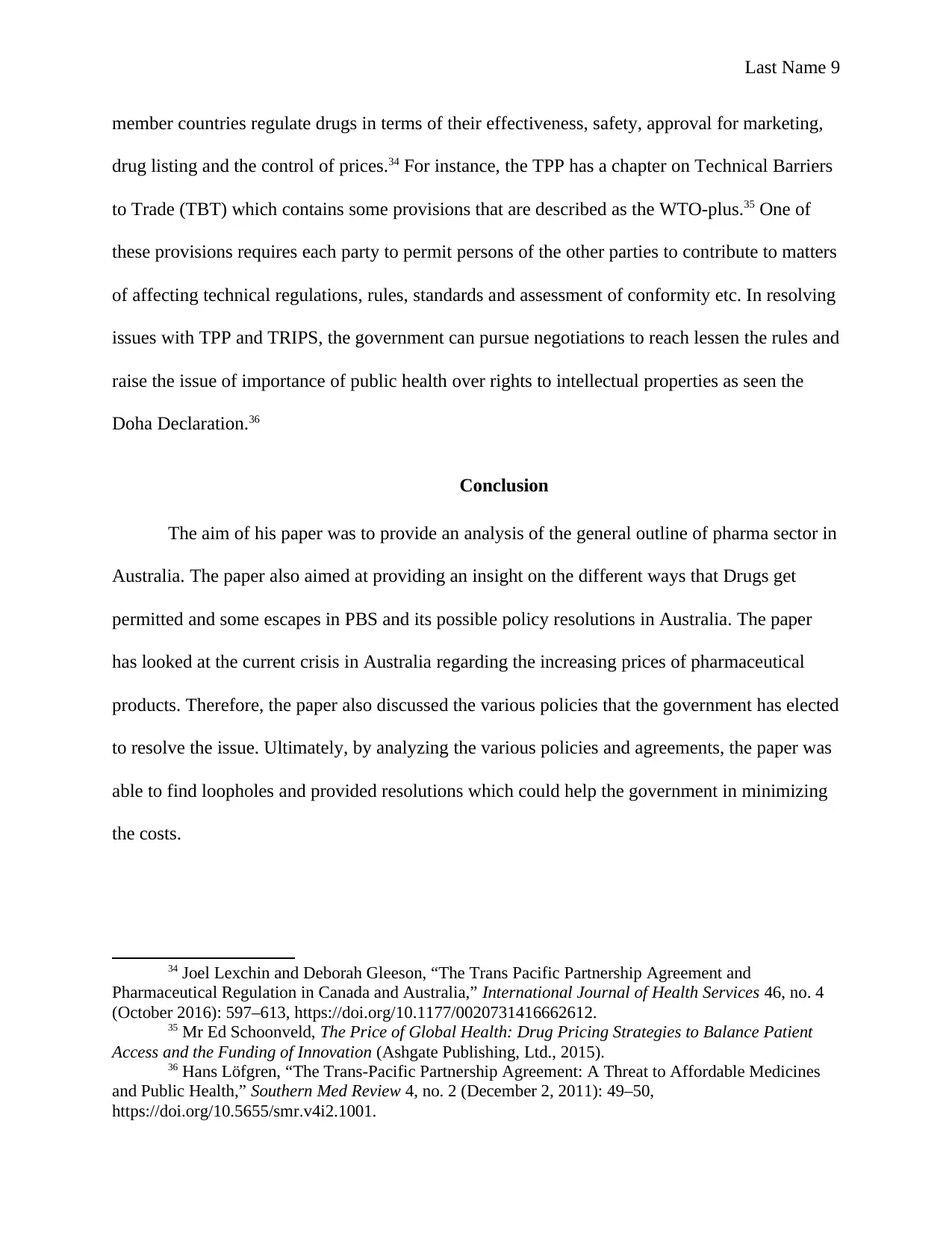
Last Name 9
member countries regulate drugs in terms of their effectiveness, safety, approval for marketing,
drug listing and the control of prices.34 For instance, the TPP has a chapter on Technical Barriers
to Trade (TBT) which contains some provisions that are described as the WTO-plus.35 One of
these provisions requires each party to permit persons of the other parties to contribute to matters
of affecting technical regulations, rules, standards and assessment of conformity etc. In resolving
issues with TPP and TRIPS, the government can pursue negotiations to reach lessen the rules and
raise the issue of importance of public health over rights to intellectual properties as seen the
Doha Declaration.36
Conclusion
The aim of his paper was to provide an analysis of the general outline of pharma sector in
Australia. The paper also aimed at providing an insight on the different ways that Drugs get
permitted and some escapes in PBS and its possible policy resolutions in Australia. The paper
has looked at the current crisis in Australia regarding the increasing prices of pharmaceutical
products. Therefore, the paper also discussed the various policies that the government has elected
to resolve the issue. Ultimately, by analyzing the various policies and agreements, the paper was
able to find loopholes and provided resolutions which could help the government in minimizing
the costs.
34 Joel Lexchin and Deborah Gleeson, “The Trans Pacific Partnership Agreement and
Pharmaceutical Regulation in Canada and Australia,” International Journal of Health Services 46, no. 4
(October 2016): 597–613, https://doi.org/10.1177/0020731416662612.
35 Mr Ed Schoonveld, The Price of Global Health: Drug Pricing Strategies to Balance Patient
Access and the Funding of Innovation (Ashgate Publishing, Ltd., 2015).
36 Hans Löfgren, “The Trans-Pacific Partnership Agreement: A Threat to Affordable Medicines
and Public Health,” Southern Med Review 4, no. 2 (December 2, 2011): 49–50,
https://doi.org/10.5655/smr.v4i2.1001.
member countries regulate drugs in terms of their effectiveness, safety, approval for marketing,
drug listing and the control of prices.34 For instance, the TPP has a chapter on Technical Barriers
to Trade (TBT) which contains some provisions that are described as the WTO-plus.35 One of
these provisions requires each party to permit persons of the other parties to contribute to matters
of affecting technical regulations, rules, standards and assessment of conformity etc. In resolving
issues with TPP and TRIPS, the government can pursue negotiations to reach lessen the rules and
raise the issue of importance of public health over rights to intellectual properties as seen the
Doha Declaration.36
Conclusion
The aim of his paper was to provide an analysis of the general outline of pharma sector in
Australia. The paper also aimed at providing an insight on the different ways that Drugs get
permitted and some escapes in PBS and its possible policy resolutions in Australia. The paper
has looked at the current crisis in Australia regarding the increasing prices of pharmaceutical
products. Therefore, the paper also discussed the various policies that the government has elected
to resolve the issue. Ultimately, by analyzing the various policies and agreements, the paper was
able to find loopholes and provided resolutions which could help the government in minimizing
the costs.
34 Joel Lexchin and Deborah Gleeson, “The Trans Pacific Partnership Agreement and
Pharmaceutical Regulation in Canada and Australia,” International Journal of Health Services 46, no. 4
(October 2016): 597–613, https://doi.org/10.1177/0020731416662612.
35 Mr Ed Schoonveld, The Price of Global Health: Drug Pricing Strategies to Balance Patient
Access and the Funding of Innovation (Ashgate Publishing, Ltd., 2015).
36 Hans Löfgren, “The Trans-Pacific Partnership Agreement: A Threat to Affordable Medicines
and Public Health,” Southern Med Review 4, no. 2 (December 2, 2011): 49–50,
https://doi.org/10.5655/smr.v4i2.1001.
Paraphrase This Document
Need a fresh take? Get an instant paraphrase of this document with our AI Paraphraser
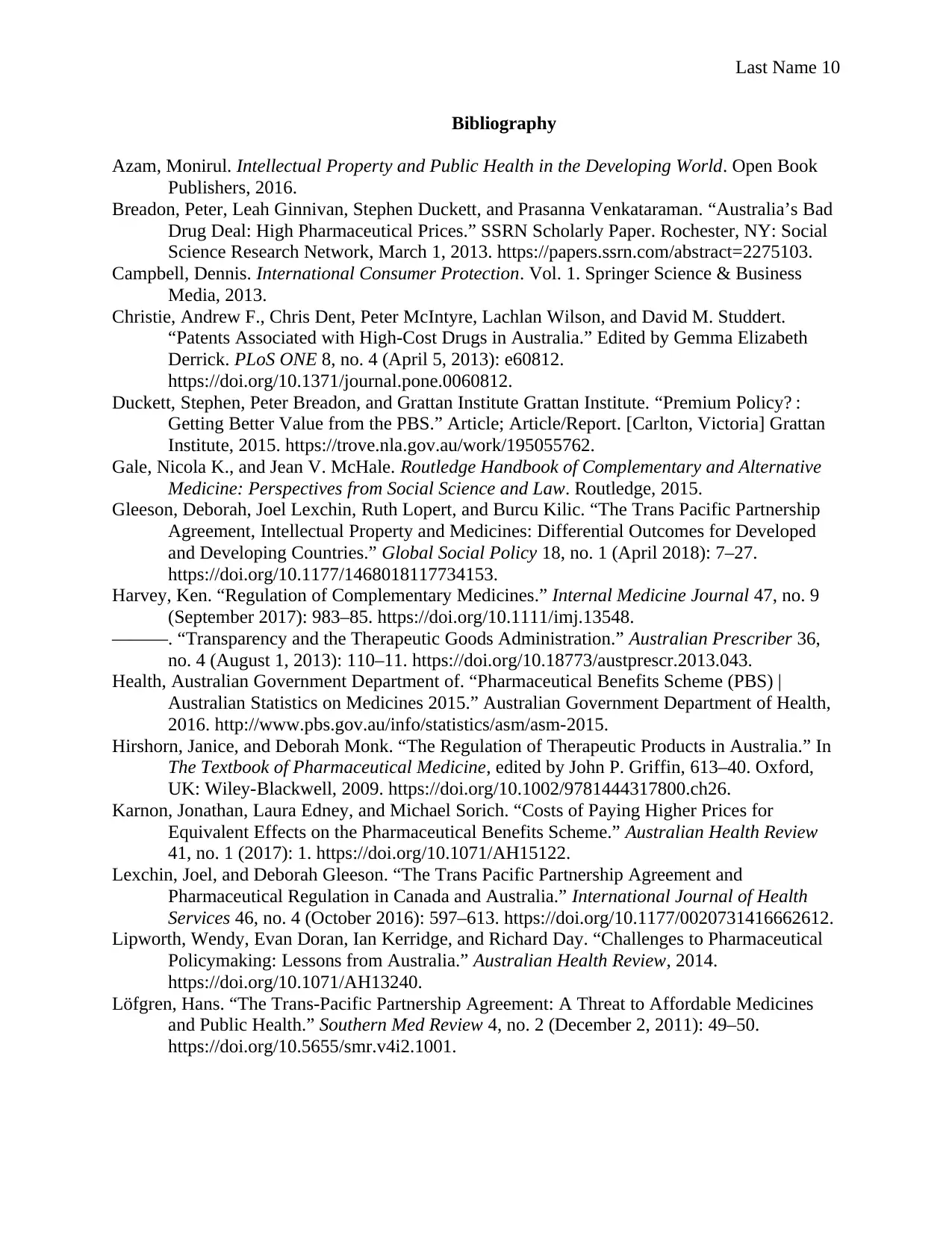
Last Name 10
Bibliography
Azam, Monirul. Intellectual Property and Public Health in the Developing World. Open Book
Publishers, 2016.
Breadon, Peter, Leah Ginnivan, Stephen Duckett, and Prasanna Venkataraman. “Australia’s Bad
Drug Deal: High Pharmaceutical Prices.” SSRN Scholarly Paper. Rochester, NY: Social
Science Research Network, March 1, 2013. https://papers.ssrn.com/abstract=2275103.
Campbell, Dennis. International Consumer Protection. Vol. 1. Springer Science & Business
Media, 2013.
Christie, Andrew F., Chris Dent, Peter McIntyre, Lachlan Wilson, and David M. Studdert.
“Patents Associated with High-Cost Drugs in Australia.” Edited by Gemma Elizabeth
Derrick. PLoS ONE 8, no. 4 (April 5, 2013): e60812.
https://doi.org/10.1371/journal.pone.0060812.
Duckett, Stephen, Peter Breadon, and Grattan Institute Grattan Institute. “Premium Policy? :
Getting Better Value from the PBS.” Article; Article/Report. [Carlton, Victoria] Grattan
Institute, 2015. https://trove.nla.gov.au/work/195055762.
Gale, Nicola K., and Jean V. McHale. Routledge Handbook of Complementary and Alternative
Medicine: Perspectives from Social Science and Law. Routledge, 2015.
Gleeson, Deborah, Joel Lexchin, Ruth Lopert, and Burcu Kilic. “The Trans Pacific Partnership
Agreement, Intellectual Property and Medicines: Differential Outcomes for Developed
and Developing Countries.” Global Social Policy 18, no. 1 (April 2018): 7–27.
https://doi.org/10.1177/1468018117734153.
Harvey, Ken. “Regulation of Complementary Medicines.” Internal Medicine Journal 47, no. 9
(September 2017): 983–85. https://doi.org/10.1111/imj.13548.
———. “Transparency and the Therapeutic Goods Administration.” Australian Prescriber 36,
no. 4 (August 1, 2013): 110–11. https://doi.org/10.18773/austprescr.2013.043.
Health, Australian Government Department of. “Pharmaceutical Benefits Scheme (PBS) |
Australian Statistics on Medicines 2015.” Australian Government Department of Health,
2016. http://www.pbs.gov.au/info/statistics/asm/asm-2015.
Hirshorn, Janice, and Deborah Monk. “The Regulation of Therapeutic Products in Australia.” In
The Textbook of Pharmaceutical Medicine, edited by John P. Griffin, 613–40. Oxford,
UK: Wiley-Blackwell, 2009. https://doi.org/10.1002/9781444317800.ch26.
Karnon, Jonathan, Laura Edney, and Michael Sorich. “Costs of Paying Higher Prices for
Equivalent Effects on the Pharmaceutical Benefits Scheme.” Australian Health Review
41, no. 1 (2017): 1. https://doi.org/10.1071/AH15122.
Lexchin, Joel, and Deborah Gleeson. “The Trans Pacific Partnership Agreement and
Pharmaceutical Regulation in Canada and Australia.” International Journal of Health
Services 46, no. 4 (October 2016): 597–613. https://doi.org/10.1177/0020731416662612.
Lipworth, Wendy, Evan Doran, Ian Kerridge, and Richard Day. “Challenges to Pharmaceutical
Policymaking: Lessons from Australia.” Australian Health Review, 2014.
https://doi.org/10.1071/AH13240.
Löfgren, Hans. “The Trans-Pacific Partnership Agreement: A Threat to Affordable Medicines
and Public Health.” Southern Med Review 4, no. 2 (December 2, 2011): 49–50.
https://doi.org/10.5655/smr.v4i2.1001.
Bibliography
Azam, Monirul. Intellectual Property and Public Health in the Developing World. Open Book
Publishers, 2016.
Breadon, Peter, Leah Ginnivan, Stephen Duckett, and Prasanna Venkataraman. “Australia’s Bad
Drug Deal: High Pharmaceutical Prices.” SSRN Scholarly Paper. Rochester, NY: Social
Science Research Network, March 1, 2013. https://papers.ssrn.com/abstract=2275103.
Campbell, Dennis. International Consumer Protection. Vol. 1. Springer Science & Business
Media, 2013.
Christie, Andrew F., Chris Dent, Peter McIntyre, Lachlan Wilson, and David M. Studdert.
“Patents Associated with High-Cost Drugs in Australia.” Edited by Gemma Elizabeth
Derrick. PLoS ONE 8, no. 4 (April 5, 2013): e60812.
https://doi.org/10.1371/journal.pone.0060812.
Duckett, Stephen, Peter Breadon, and Grattan Institute Grattan Institute. “Premium Policy? :
Getting Better Value from the PBS.” Article; Article/Report. [Carlton, Victoria] Grattan
Institute, 2015. https://trove.nla.gov.au/work/195055762.
Gale, Nicola K., and Jean V. McHale. Routledge Handbook of Complementary and Alternative
Medicine: Perspectives from Social Science and Law. Routledge, 2015.
Gleeson, Deborah, Joel Lexchin, Ruth Lopert, and Burcu Kilic. “The Trans Pacific Partnership
Agreement, Intellectual Property and Medicines: Differential Outcomes for Developed
and Developing Countries.” Global Social Policy 18, no. 1 (April 2018): 7–27.
https://doi.org/10.1177/1468018117734153.
Harvey, Ken. “Regulation of Complementary Medicines.” Internal Medicine Journal 47, no. 9
(September 2017): 983–85. https://doi.org/10.1111/imj.13548.
———. “Transparency and the Therapeutic Goods Administration.” Australian Prescriber 36,
no. 4 (August 1, 2013): 110–11. https://doi.org/10.18773/austprescr.2013.043.
Health, Australian Government Department of. “Pharmaceutical Benefits Scheme (PBS) |
Australian Statistics on Medicines 2015.” Australian Government Department of Health,
2016. http://www.pbs.gov.au/info/statistics/asm/asm-2015.
Hirshorn, Janice, and Deborah Monk. “The Regulation of Therapeutic Products in Australia.” In
The Textbook of Pharmaceutical Medicine, edited by John P. Griffin, 613–40. Oxford,
UK: Wiley-Blackwell, 2009. https://doi.org/10.1002/9781444317800.ch26.
Karnon, Jonathan, Laura Edney, and Michael Sorich. “Costs of Paying Higher Prices for
Equivalent Effects on the Pharmaceutical Benefits Scheme.” Australian Health Review
41, no. 1 (2017): 1. https://doi.org/10.1071/AH15122.
Lexchin, Joel, and Deborah Gleeson. “The Trans Pacific Partnership Agreement and
Pharmaceutical Regulation in Canada and Australia.” International Journal of Health
Services 46, no. 4 (October 2016): 597–613. https://doi.org/10.1177/0020731416662612.
Lipworth, Wendy, Evan Doran, Ian Kerridge, and Richard Day. “Challenges to Pharmaceutical
Policymaking: Lessons from Australia.” Australian Health Review, 2014.
https://doi.org/10.1071/AH13240.
Löfgren, Hans. “The Trans-Pacific Partnership Agreement: A Threat to Affordable Medicines
and Public Health.” Southern Med Review 4, no. 2 (December 2, 2011): 49–50.
https://doi.org/10.5655/smr.v4i2.1001.
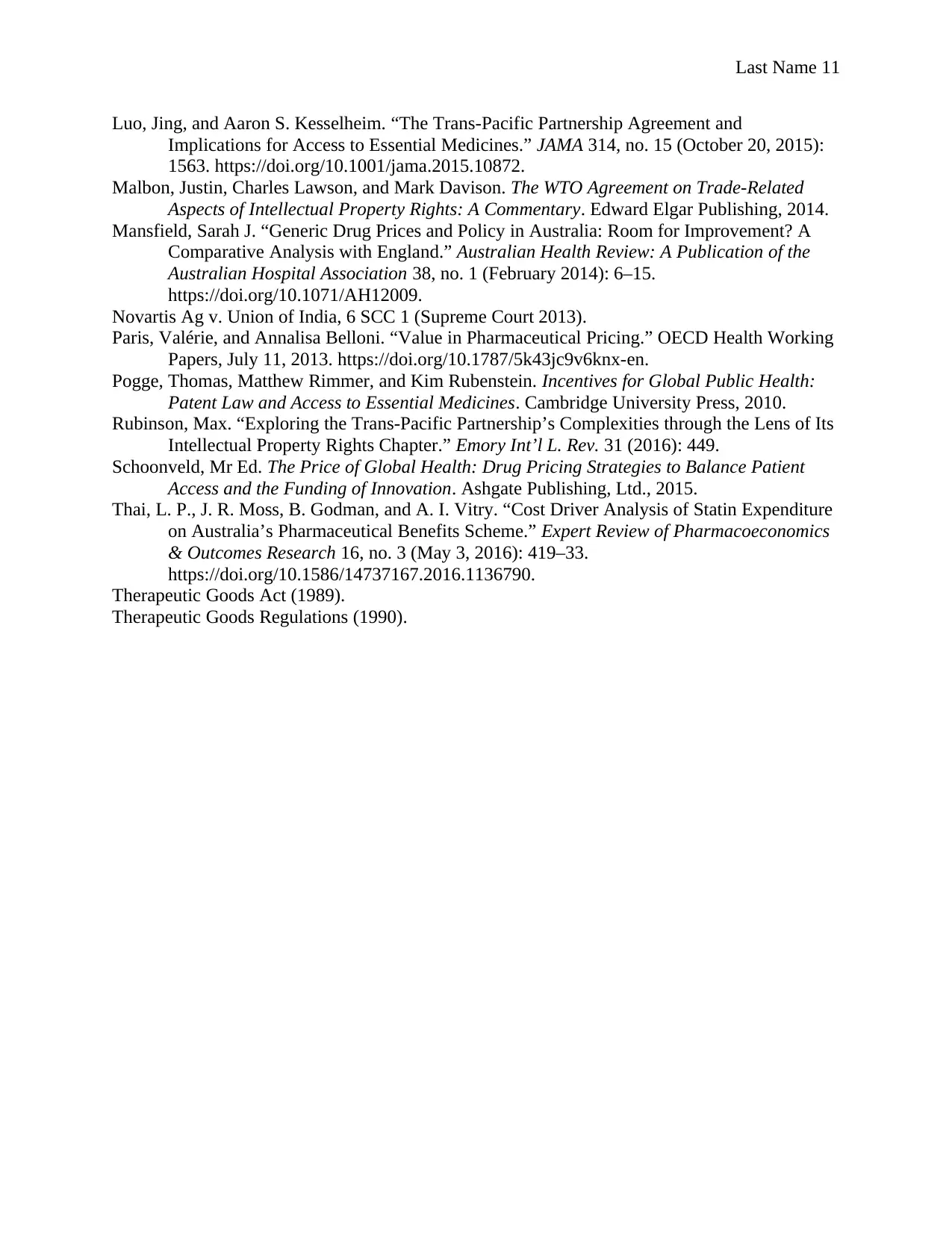
Last Name 11
Luo, Jing, and Aaron S. Kesselheim. “The Trans-Pacific Partnership Agreement and
Implications for Access to Essential Medicines.” JAMA 314, no. 15 (October 20, 2015):
1563. https://doi.org/10.1001/jama.2015.10872.
Malbon, Justin, Charles Lawson, and Mark Davison. The WTO Agreement on Trade-Related
Aspects of Intellectual Property Rights: A Commentary. Edward Elgar Publishing, 2014.
Mansfield, Sarah J. “Generic Drug Prices and Policy in Australia: Room for Improvement? A
Comparative Analysis with England.” Australian Health Review: A Publication of the
Australian Hospital Association 38, no. 1 (February 2014): 6–15.
https://doi.org/10.1071/AH12009.
Novartis Ag v. Union of India, 6 SCC 1 (Supreme Court 2013).
Paris, Valérie, and Annalisa Belloni. “Value in Pharmaceutical Pricing.” OECD Health Working
Papers, July 11, 2013. https://doi.org/10.1787/5k43jc9v6knx-en.
Pogge, Thomas, Matthew Rimmer, and Kim Rubenstein. Incentives for Global Public Health:
Patent Law and Access to Essential Medicines. Cambridge University Press, 2010.
Rubinson, Max. “Exploring the Trans-Pacific Partnership’s Complexities through the Lens of Its
Intellectual Property Rights Chapter.” Emory Int’l L. Rev. 31 (2016): 449.
Schoonveld, Mr Ed. The Price of Global Health: Drug Pricing Strategies to Balance Patient
Access and the Funding of Innovation. Ashgate Publishing, Ltd., 2015.
Thai, L. P., J. R. Moss, B. Godman, and A. I. Vitry. “Cost Driver Analysis of Statin Expenditure
on Australia’s Pharmaceutical Benefits Scheme.” Expert Review of Pharmacoeconomics
& Outcomes Research 16, no. 3 (May 3, 2016): 419–33.
https://doi.org/10.1586/14737167.2016.1136790.
Therapeutic Goods Act (1989).
Therapeutic Goods Regulations (1990).
Luo, Jing, and Aaron S. Kesselheim. “The Trans-Pacific Partnership Agreement and
Implications for Access to Essential Medicines.” JAMA 314, no. 15 (October 20, 2015):
1563. https://doi.org/10.1001/jama.2015.10872.
Malbon, Justin, Charles Lawson, and Mark Davison. The WTO Agreement on Trade-Related
Aspects of Intellectual Property Rights: A Commentary. Edward Elgar Publishing, 2014.
Mansfield, Sarah J. “Generic Drug Prices and Policy in Australia: Room for Improvement? A
Comparative Analysis with England.” Australian Health Review: A Publication of the
Australian Hospital Association 38, no. 1 (February 2014): 6–15.
https://doi.org/10.1071/AH12009.
Novartis Ag v. Union of India, 6 SCC 1 (Supreme Court 2013).
Paris, Valérie, and Annalisa Belloni. “Value in Pharmaceutical Pricing.” OECD Health Working
Papers, July 11, 2013. https://doi.org/10.1787/5k43jc9v6knx-en.
Pogge, Thomas, Matthew Rimmer, and Kim Rubenstein. Incentives for Global Public Health:
Patent Law and Access to Essential Medicines. Cambridge University Press, 2010.
Rubinson, Max. “Exploring the Trans-Pacific Partnership’s Complexities through the Lens of Its
Intellectual Property Rights Chapter.” Emory Int’l L. Rev. 31 (2016): 449.
Schoonveld, Mr Ed. The Price of Global Health: Drug Pricing Strategies to Balance Patient
Access and the Funding of Innovation. Ashgate Publishing, Ltd., 2015.
Thai, L. P., J. R. Moss, B. Godman, and A. I. Vitry. “Cost Driver Analysis of Statin Expenditure
on Australia’s Pharmaceutical Benefits Scheme.” Expert Review of Pharmacoeconomics
& Outcomes Research 16, no. 3 (May 3, 2016): 419–33.
https://doi.org/10.1586/14737167.2016.1136790.
Therapeutic Goods Act (1989).
Therapeutic Goods Regulations (1990).
⊘ This is a preview!⊘
Do you want full access?
Subscribe today to unlock all pages.

Trusted by 1+ million students worldwide
1 out of 12
Related Documents
Your All-in-One AI-Powered Toolkit for Academic Success.
+13062052269
info@desklib.com
Available 24*7 on WhatsApp / Email
![[object Object]](/_next/static/media/star-bottom.7253800d.svg)
Unlock your academic potential
Copyright © 2020–2025 A2Z Services. All Rights Reserved. Developed and managed by ZUCOL.




